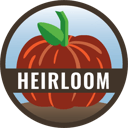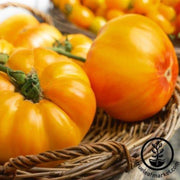Out Of Stock!
We will notify you when this product becomes available.
Tomato Seeds - Slicing - Gold Medal
90 Days to maturity (from transplant). Solanum lycopersicum. Gold Medal Tomato Seeds. Non-GMO, warm season annual, open-pollinated, heirloom, indeterminate, slicing tomato. Suitable for growing in garden plots, raised beds, and greenhouses. Gold Medal tomatoes are beautiful and bicolored, and their skin is golden with rosy-red blushes. Approximately 6,800 seeds/ounce.




Download Free Vegetable Growing Guide PDF
Growing Gold Medal Yellow Slicer Tomatoes in the Vegetable Garden
Growing tomatoes from seed can be a rewarding experience, and with the right approach, it's possible in any climate. Begin indoors, 7-9 weeks before the last expected frost. Use a high-quality seed-starting mix and sow the seeds at a depth of 1/4 inch. Maintain consistent moisture and provide adequate light, either from natural sunlight or grow lights, to ensure robust seedling growth. As the seedlings reach about 2 inches in height and develop true leaves, transplant them into larger containers with nutrient-rich potting soil, fostering healthy root development.
Care for your tomato seedlings by maintaining a consistent watering schedule, keeping the soil consistently moist but not waterlogged. Use a balanced fertilizer according to package instructions to provide essential nutrients for vigorous growth. To support the growing plants, stake or cage them as they mature, preventing sprawling and reducing the risk of diseases.
When it's time to transplant into the garden, choose a sunny location with well-drained soil. Proper spacing, typically 18-24 inches apart, is essential to allow for optimal air circulation. Consider mulching around the base of the plants to retain moisture, suppress weeds, and regulate soil temperature. Tomatoes thrive in full sun, so ensure they receive at least 6-8 hours of direct sunlight daily for optimal growth.
Companion planting is a beneficial practice in tomato cultivation. Consider planting basil, marigolds, or nasturtiums nearby to help deter pests and enhance flavor. As your seedlings mature, gradually expose them to outdoor conditions through a process called hardening off. Place them in a shaded and sheltered location for a few hours each day, gradually increasing their exposure to direct sunlight and wind over 7-10 days. This helps acclimate the plants to the outdoor environment, reducing the risk of transplant shock.
Fertilize your tomatoes throughout the growing season, following recommended guidelines. Tomatoes are heavy feeders, and a balanced fertilizer helps ensure robust growth and bountiful harvests. Regular monitoring for pests and diseases is crucial, allowing for early intervention with natural remedies or organic pesticides. With careful attention to these aspects, you can successfully grow tomatoes from seed in any climate, enjoying a satisfying harvest of fresh and flavorful tomatoes.
Harvesting Gold Medal Yellow Tomatoes
Harvesting indeterminate tomato varieties involves picking ripe fruits continuously throughout the growing season. Begin harvesting when tomatoes reach full color and firmness, gently twisting or cutting the stems with pruners. Indeterminate plants yield tomatoes at different stages of ripeness, so regular harvesting encourages further fruit development. Check plants regularly, focusing on the lower branches first. Harvesting indeterminate tomatoes consistently ensures a prolonged supply of fresh, flavorful fruits for culinary use or preservation.
About Heirloom Gold Medal Yellow Tomato Garden Seeds
Indeterminate tomato plants offer a range of benefits, making them a popular choice for gardeners. Their continuous growth throughout the season leads to an extended harvest, providing a steady supply of fresh tomatoes. This characteristic makes them ideal for home gardeners who desire a prolonged harvesting period for culinary use or preserving. Indeterminate tomatoes are often favored for their potential for larger overall yields, as the plants continue to produce fruit until frost, maximizing the return on the gardener's effort and resources.
Gold Medal Yellow Tomatoes stand out among other yellow tomato varieties due to their unique combination of size, flavor, and appearance. Known for their large, beefsteak-style fruits, these tomatoes boast a golden-yellow hue when fully ripe. The flavor profile is often described as sweet with a subtle tang, making them suitable for various culinary applications. The distinct characteristics of Gold Medal Yellow Tomatoes make them a sought-after choice for gardeners looking to cultivate visually striking, flavorful yellow tomatoes in their home gardens.
Gold Medal tomatoes are beautiful and bicolored, and their skin is golden with rosy-red blushes. A tasty treat, best eaten fresh. This delicious tomato's flesh is sweet and mild, making for a wonderful, juicy summer snack.
Gold Medal Yellow Tomatoes, with their sweet and tangy flavor, are versatile and can be used in various recipes. Consider using them in fresh salads for a burst of color and flavor, where their juicy texture complements other crisp vegetables. Create a vibrant and flavorful pasta sauce or salsa, showcasing the tomatoes' unique color and taste.
Their large size makes them suitable for slicing onto sandwiches or burgers, adding both visual appeal and a delicious twist. The sweet profile of Gold Medal Yellow Tomatoes also pairs well with fresh herbs in bruschettas or as toppings for homemade pizzas. Experimenting with these tomatoes in different dishes allows their distinct qualities to shine through.
Tips From Our Gardeners
"Before transplanting, it's beneficial to conduct a soil test to ensure the soil pH and nutrient levels are suitable for tomatoes. Contact your local extension office to see what resources are available for your area!"
 |
- Lara Wadsworth, True Leaf Market Writer |
Other Resources
Gold Medal Yellow Tomato Seeds Per Package:
- 300 mg packet - Approximately 65 Seeds
- .25 oz - Approximately 1,700 Seeds
- 1 oz - Approximately 6,800 Seeds
- 4 oz - Approximately 27,200 Seeds
- 1 lb - Approximately 108,800 Seeds
Non-GMO Gold Medal Yellow Tomato seeds are available for Fast Free Shipping on qualifying orders.
Basic Info
| Latin Name: | Solanum lycoperscium (previously Lycopersicon esculentum) |
| Tomato Type: | Slicing - Larger, round tomatoes, the size of your fist or larger. |
| Gold Medal Tomato Color: | Yellow, Red, Orange, Bicolor |
| Gold Medal Tomato Flavor: | Sweet, mild, juicy |
Growing Info
| Hardiness Zone: | 2, 3, 4, 5, 6, 7, 8, 9, 10, 11 Annual: Not intended to overwinter |
| Days to Maturity: | 90 (from transplant) |
| Days to Germination: | 7-10 |
| Seeding Depth: | 0.25 inch |
| Plant Spacing: | 18-24 inches |
| Row Spacing: | 36 inches |
| Plant Height: | 48-84 inches |
| Growth Habit: | Indeterminate - Indeterminate tomatoes are vine-type plants that sprawl (requiring a cage or trellis to support them) and continue to grow throughout the season. Indeterminate tomato plants will continue to produce tomatoes for the rest of the season, so you can harvest continually. |
| Soil Preference: | Well-draining, loose (sandy loam), slightly acidic (6.2 to 6.8), and moisture retaining. Too much nitrogen in the soil may lead to more foliage production and less fruiting. Tomatoes like more phosphorus and potassium than other vegetables. |
| Temperature Preference: | Warmer (70-85 F) |
| Light Preference: | Full Sun |
Other
| Direct Sow: | No |
| Start Indoors: | Yes. Start Indoors 7-9 weeks before your last spring frost date. |
| Plant Width: | 24 inches |
| Plant Spread: | 24 inches |
| Growth Speed: | Late - Ready to harvest from 81 days or more from transplant. Difficult, if not impossible, to get a tomato by the 4th of July with these varieties. They are good late-summer to early-fall producers for most USDA Zones. |
| Germination Temperature: | 65-85 F |
| Pests and Diseases: | Common pests known to harm tomato plants, in general, include the tomato hornworm, cutworm, aphids, flea beetles, tomato fruit worms, and whiteflies. Also, watch for common diseases such as blossom end rot, fusarium wilt, powdery mildew, verticillium wilt, late blight, bacterial canker/spot, and tobacco mosaic virus. Most of these can be prevented by maintaining a regular watering schedule and avoiding overwatering. Regularly check your plants for pest damage throughout the season. For treating pest and disease problems, we recommend using an organic neem-based product. |
| Garden Size: | Greenhouse, Garden Plot, Raised Bed |
| Tomato Use: | Salads, fresh eating, slicing |














